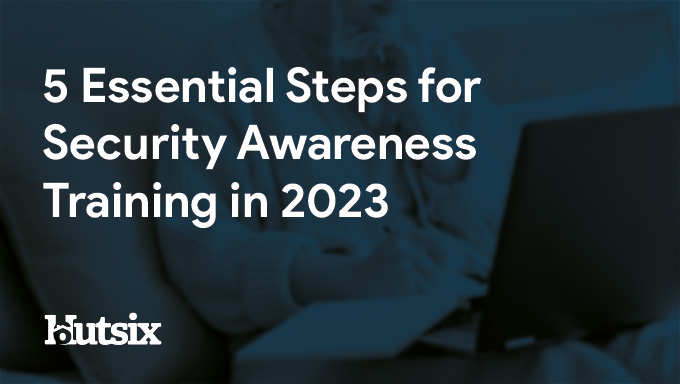Explained: The Different Types of Security Awareness Training
Ensuring that employees are well-versed in security protocols is a critical aspect of any organisation's defence against cyber threats. Security awareness training plays a pivotal role in fortifying an organisation's human firewall.
In this blog, we delve into the intricacies of the four primary types of security training, shedding light on their effectiveness and relevance in the contemporary business environment, and helping you make an informed decision about which training solution is right for you.
Looking for the right security training for your organisation?
Talk to one of our experts about effective training now.
What are the Four Kinds of Security Training?
To establish a robust defence against cyber threats, organisations deploy various security training methodologies. The four most common of which are:
1) Classroom: Traditional, paper and worksheets, difficult to scale.
2) Basic Web-Based: Text-heavy, quizzes, not typically engaging.
3) Interactive Web-Based: Engaging, customisable, scalable.
4) Simulated Phishing: Real-world feedback/metrics, practical, supplemental.
Classroom Training
Classroom training, a traditional approach to security awareness, involves conducting in-person sessions where an instructor imparts knowledge to a group of participants. These sessions typically cover a range of security topics, from basic principles to specific protocols. Classroom training often incorporates presentations, discussions, and Q&A sessions.
While classroom training was once a primary method for disseminating security knowledge, its effectiveness has faced challenges in the modern business landscape. The limitations of time, logistical constraints, and the evolving nature of cybersecurity threats have prompted organisations to explore more dynamic and scalable training solutions.
While there are still strengths associated with this form of training, for instance, lending itself to more advanced or specialised knowledge, the static nature of traditional lectures may hinder active engagement and knowledge retention among participants.
Read More: 15 Essential Cyber Awareness Training Topics for 2024
As businesses strive to meet the demands of a global and digitally connected workforce, the constraints associated with classroom training have led to the rise of alternative methods, such as interactive training and simulated phishing campaigns.
Basic Web-Based Training
Basic web-based training, while a traditional approach, is deemed less effective in today's fast-evolving threat landscape. This method, often text-heavy and lacking interactivity, may struggle to engage participants, leading to suboptimal retention of crucial security information.
This method involves the delivery of security awareness content through web-based platforms, typically consisting of text-based materials, images, and occasional quizzes. The content is often static and lacks the interactive elements that characterise more advanced training methods.
Read More: What is the Impact of Security Awareness Training?
As organisations strive for compliance and comprehensive security management training, basic web-based approaches may fall short of meeting the dynamic challenges of the digital realm.
Interactive Web-Based Training
In contrast to basic web-based training, newer methodologies such as interactive web-based training offer a more engaging and immersive learning experience.
By appealing to visual and auditory senses, organisations ensure that participants are not mere spectators but active participants in the learning journey.
Incorporating multimedia elements, scenario-based learning, and interactive modules, this modern form of training can enhance employees' understanding of security concepts and better prepare them to navigate the complexities of the modern digital landscape.
Learn More: Effective Interactive Training
Furthermore, some interactive web-based training providers (including Hut Six) offer organisations the opportunity to automatically and easily customise content to fit security policies seamlessly, making it as relevant as possible to employees.
Interactive web-based training not only captures attention but also ensures better retention of key concepts, making it a powerful tool in providing security training for employees. As organisations adapt to the ever-changing cybersecurity landscape, investing in interactive web-based training is quickly becoming an essential.
Simulated Phishing Training
Simulated phishing training represents a proactive and hands-on approach to security awareness, specifically targeting one of the most prevalent cyber threats -- phishing attacks. In this training method, organisations create simulated phishing scenarios that mimic real-world threats, testing employees' ability to recognise and respond to phishing attempts.
Simulated phishing aims to provide a practical and realistic experience, allowing participants to apply the knowledge gained from other training methods, such as interactive web-based training. By simulating phishing attacks, organisations can gauge the effectiveness of their employees' awareness and response mechanisms in a controlled environment.
Read More: How to Measure the Effectiveness of Security Awareness Training
As a highly effective addition to interactive web-based training, simulated phishing takes the knowledge a step further by evaluating their ability to identify and thwart actual phishing attempts.
Participants are exposed to simulated phishing emails or messages, and their responses are monitored and assessed. This feedback loop allows organisations to tailor additional training based on the specific weaknesses identified during the simulations. This targeted approach ensures that employees not only understand the theoretical aspects of security but can also apply their knowledge in real-world scenarios.
In the context of both compliance and security management training, simulated phishing serves as a valuable tool for reinforcing key concepts and enhancing the practical skills needed to combat phishing threats.
Which Kind is the most Effective?
In the quest for the most effective security training, a blended approach proves optimal. Combining the interactive elements of web-based training with the practical application of simulated phishing creates a comprehensive and resilient defence against evolving cyber threats. This multifaceted strategy ensures that employees not only understand security protocols but can also apply them effectively in real-world situations.
Learn More: Effective Interactive Training
By embracing modern training methodologies and supplementing them with practical exercises like simulated phishing, businesses can foster a vigilant and security-conscious workforce. In an era where cyber threats continue to evolve, proactive security training remains a linchpin in safeguarding organisational assets and maintaining compliance with ever-stringent security standards.
Security Awareness for your Organisation
Enjoyed our blog? Learn more about how Hut Six can help improve you security awareness with training and simulated phishing. Start a free trial now, or book a meeting with one of our experts.
Featured
What is the Impact of Security Awareness Training? - Hut Six
Discover the Impact of Security Awareness Training: Prevent breaches, foster culture, & build trust.
What is Personal Data?
Learn about personal data, its types, and significance in data protection. Explore general and special category data, as well as pseudonymised and anonymised data under the GDPR.
Who Does GDPR Apply To?
Who Does GDPR Apply To? And Other Data Protection Questions/ Information Security blog by Information security awareness provider Hut Six Security.
Does ChatGPT Pose a Cybersecurity Risk
In this blog post, we explore whether AI chatbots like ChatGPT pose a cybersecurity risk. We delve into the potential vulnerabilities and threats posed by chatbots, and discuss measures that can be taken to mitigate these risks. Read on to discover how you can ensure the security of your organisation's chatbot interactions.
How Do I Get Cyber Essentials Certified?
Learn how to obtain Cyber Essentials certification and enhance your organization's cybersecurity posture with our comprehensive guide. Our expert insights will help you navigate the certification process to meet the requirements for Cyber Essentials.
Essential Steps for Security Awareness Training
Starting a security awareness training campaign? Here are 5 essential steps to help ensure information security success.
Malicious Insider Threats - Meaning & Examples
Malicious insider threats can cause massive problems. Here we examine some of the motivations behind attacks and methods of detection organisations can use to reduce risk.
5 Biggest Breaches of 2022 (So Far)
Five of the biggest and most significant data breaches, hacks, and information security attacks of 2022 (so far).
Auditing for GDPR Compliance
Questions to consider when auditing your business or SME for General Data Protection Regulation (GDPR) compliance.
Improving Employee Cyber Security
With human error responsible for many breaches and attacks, we offer some helpful areas for improving employee security compliance.












